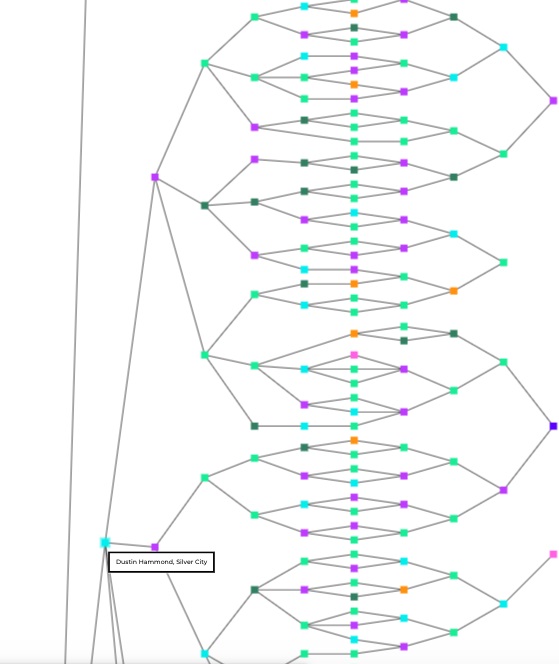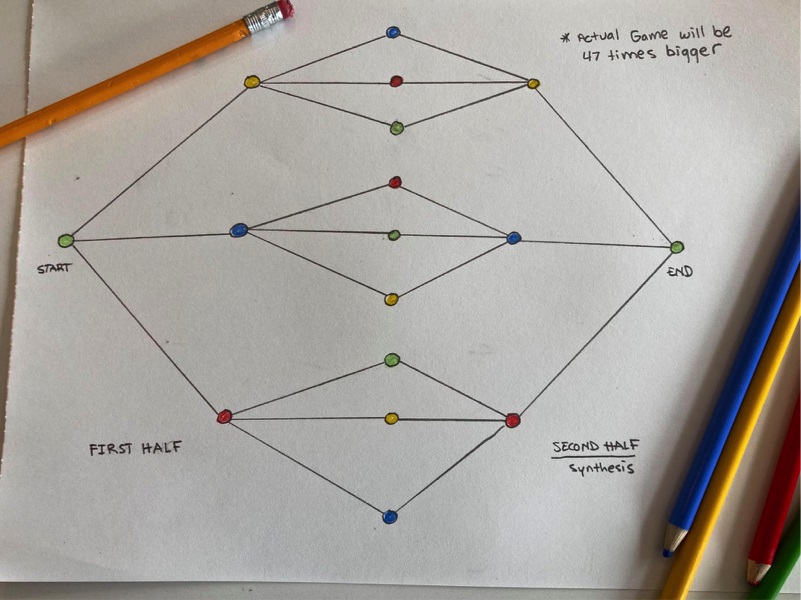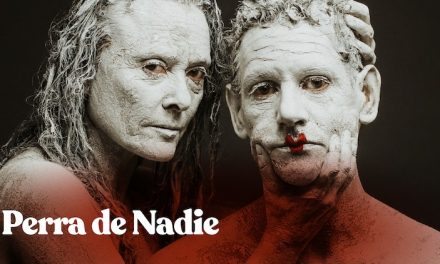In the internationally popular children’s game of Telephone or Chinese Whispers as it is called in the United Kingdom and Australia, involves players forming a line or circle, the first player creating a message which she/he whispers in the ear of player number two. This process repeats down the line or around the circle until the last player announces to the entire group what the message is that they heard. Anyone who has played this game knows that more often than not, the final message compares little to the original. That is, of course, the fun of playing the game. Wikipedia states that “the game is often invoked as a metaphor for cumulative error, especially the inaccuracies as rumors or gossip spread, or, more generally, for the unreliability of human recollection or even oral traditions”. The game is also known as Dengon, Teléfono Descompuesto, Operator, Głuchy Telefon, Stille Post, Telefon Shavur, and countless other names around the world.
Formed in 2010, the New York City based Satellite Collective with regional homes on Lake Michigan, and the Pacific Northwest is led by Artistic Director, Architect, and Resident Writer Kevin Draper. Its members include visual artists, writers, and composers from across the United States, and has produced five seasons of multi-disciplinary work during summer residencies held in NYC and Michigan.
Satellite Collective has just announced the Online Exhibition of Worldwide Game of TELEPHONE involving more than 950 Artists from 70 countries presenting hundreds of original, interconnected works will debut to the public for free on Saturday, April 10, 2021 at 9am Eastern – 6am Pacific (link provided below). During this version of the game which began on March 23, 2020, a message was passed from art form to art form; a message could “become a poem, then a painting, then a film, then a dance, as it was passed 7,177,703 kilometers between 489 cities,” and ran for a total of 383 days.
The original message of TELEPHONE was shared with only a few staff members and the artists participating in the game were only award of the work that preceded theirs. They also did not know exactly how their work would be translated down the line. The artists will see the final results at the same time as the viewers when it is aired publicly. Satellite Collective incubated the first generation of TELEPHONE with composer and musician Nathan Langston in 2015, and partners now with an additional group of artists. It was the onset of the Covid-19 pandemic that became the inspiration to begin TELEPHONE anew with a different team in the Pacific Northwest. This form of the game requires no physical contact between participants but helps to intimately connect individuals in isolation, especially those in countries worst hit by the pandemic.
Only a handful of staff members know the original message of TELEPHONE. The participating artists are only aware of the work that directly preceded their own, and do not know how their own work was translated or further translated in subsequent. When TELEPHONE becomes publicly available, it will be the first time that any of the artists get to see the exhibition in full.
“It’s amazing to come full circle,” said Kevin Draper, Artistic Director, Satellite Collective. “Nathan launched the first Telephone game as a Satellite Program, working directly with us. TELEPHONE is one of our most successful incubations, and now we partner with them in an unexpected way: the Winter 2021 Satellite Fellows cohort, we’re proud to say, was drawn from the TELEPHONE game.”
How were the artists chosen? They were primarily recruited by word-of-mouth and various international message boards. Approximately 60% of the artists are based in the United States and roughly 65% are women. They range from “Guggenheim Fellows to newly emerging artists, from high school students and elderly artists just developing their practices to Academy Award and Pulitzer Prize winners”.
Some consider TELEPHONE as a presentation of individual and original works of art while others might view it as a single work of art by people from around the world. The results are considered to be the largest data set of ekphrastic artistic exchange in history.
“Unlike the children’s game, this TELEPHONE message was not whispered in a straight line. Each finished work was assigned to two or three other artists, so the game branched out exponentially like a family tree. Halfway through, the process was reversed, meaning that the game contracted exponentially so that TELEPHONE, which began with a single message, will be passed through almost 1,000 artists, and conclude with a single work of art. This helps us better understand each art form, the neurological processes at work in translation, and how information is passed from person to person. The second half of the game employs synthesis, allowing us to study how artists combine multiple influences simultaneously.” Press release – Michelle Tabnick PR – March 30, 2021.
It has taken a team of professional UX designers and a talented group of engineers and developers to create the user interface of the online exhibition. Viewers of TELEPHONE will have the opportunity to explore each work of art from the original message to the final work. After that, they could, if they so choose, start over and select “another of the hundreds of contiguous pathways through the exhibition”. A geographic map will be provided to each visitor of the exhibition as well as a game map designed to aid views navigate through the game’s structure. The exhibition platform, was designed and built from scratch, has integrated more than 10,000 artist files.
The TELEPHONE exhibition involves a ten-member team, most of whom have never physically met. The team members come from a variety of tech companies including Google, Microsoft, T-Mobile, Dropbox, as well as a number of academic institutions. It has been estimated that over 10,000 hours have gone into curating and presenting TELEPHONE and all of the staff are working for free. It was noted that the entire cost of this project was a mere $150 and that no income will be generated.
The Satellite Collective team includes writer, consultant, and project manager Katelyn Watkins, who now divides her time between Austin, Texas, and Worthing, Barbados. She is currently working on her first collection of short stories. Matt Diehl is a software engineer and designer at Google, currently living in Jersey City who also enjoys playing guitar in a ukelele punk band, Paul Newman and the Ride Home. Ben Sarsgard is a software engineer in Baltimore and/or New York. Kelly Jones resides in Piedmont of NC, earned an MFA in Poetry and a master’s in library and Information Studies, and before the pandemic managed the Outreach & Education Department of a creative reuse non-profit. Ramon M. Rodriguez is a UX/UI/Visual designer at HCL Technologies, currently living just outside Seattle. Jennifer Spriggs is a designer living in Seattle. Sergio Rodriguez is a Graphic Designer that moved from Arizona to Seattle in 2012 and hopes to make a career change to UX design. Madeline Hoak is an artist and academic who creates with, through and about circus. She is an Adjunct Professor of Aerial Arts at Pace University (NYC), an Associate Editor for Circus Talk, and a graduate student at New York University where she is designing a degree in Circus Studies with a focus on spectatorship. Sean Tomas Redmond is an artist living in Austin, Texas. He has played in a wide variety of musical projects in Chicago, Austin, and Japan, and recently performed shows with artists including Mark Renner, Sean McCann, Sarah Davachi, and Future Museums. Redmond is also a designer, amateur painter and photographer, and the former editor-in-chief of the arts publication fields magazine.
The list of participating artists is too long to include here, but I have singled out those who state that they are from the Los Angeles area. Their names are Charlie Clements, Holly Boruck, Ben Fee, Freyja Bardell, J. Rick Castañeda, Kimberly Cooper, Sean Miller, Yusuf Yildiz, Marlys West, Macy McKenny, Linda Dove, Ari Gold, Darryl Blood, Julie Borsa, Karen Hochman Brown, Darrell Larson, Ethan Gold, Kate Gale, Therese Conte, Joseph Matick, and Julie Kornblum.
TELEPHONE will debut to the public for free on Saturday, April 10, 2021 at 9am Eastern – 6am Pacific. To view the exhibit, click HERE.
To learn more about Satellite Collective, click HERE .
To learn more about Artistic Director Kevin Draper, click HERE.
To learn more about Nathan Langston, click HERE.
Written by Jeff Slayton for LA Dance Chronicle.
Featured image: From the web













